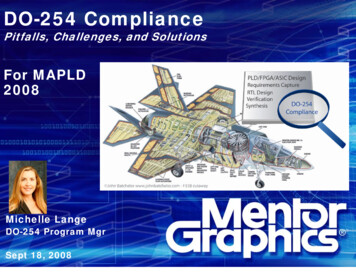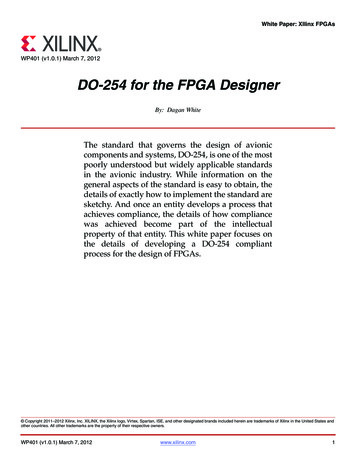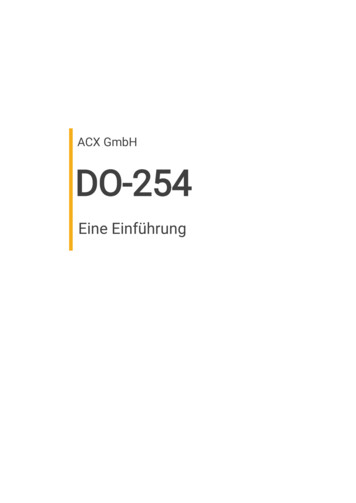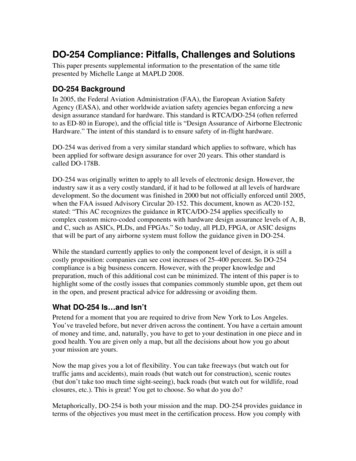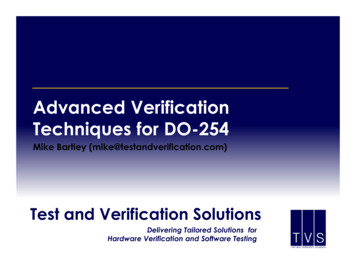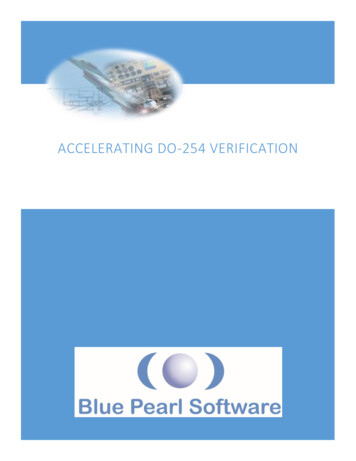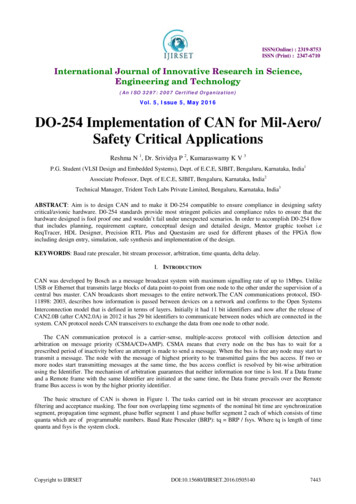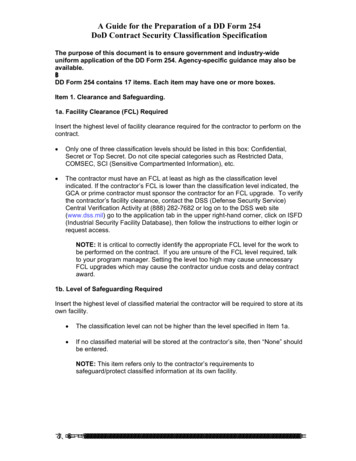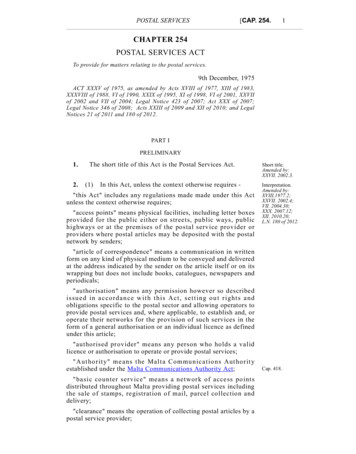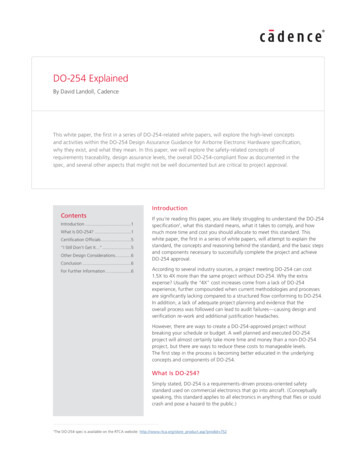
Transcription
DO-254 ExplainedBy David Landoll, CadenceThis white paper, the first in a series of DO-254-related white papers, will explore the high-level conceptsand activities within the DO-254 Design Assurance Guidance for Airborne Electronic Hardware specification,why they exist, and what they mean. In this paper, we will explore the safety-related concepts ofrequirements traceability, design assurance levels, the overall DO-254-compliant flow as documented in thespec, and several other aspects that might not be well documented but are critical to project approval.IntroductionContentsIntroduction.1What Is DO-254? .1Certification Officials.5“I Still Don’t Get It ”.5Other Design Considerations.6Conclusion.6For Further Information.6If you’re reading this paper, you are likely struggling to understand the DO-254specification1, what this standard means, what it takes to comply, and howmuch more time and cost you should allocate to meet this standard. Thiswhite paper, the first in a series of white papers, will attempt to explain thestandard, the concepts and reasoning behind the standard, and the basic stepsand components necessary to successfully complete the project and achieveDO-254 approval.According to several industry sources, a project meeting DO-254 can cost1.5X to 4X more than the same project without DO-254. Why the extraexpense? Usually the “4X” cost increases come from a lack of DO-254experience, further compounded when current methodologies and processesare significantly lacking compared to a structured flow conforming to DO-254.In addition, a lack of adequate project planning and evidence that theoverall process was followed can lead to audit failures—causing design andverification re-work and additional justification headaches.However, there are ways to create a DO-254-approved project withoutbreaking your schedule or budget. A well planned and executed DO-254project will almost certainly take more time and money than a non-DO-254project, but there are ways to reduce these costs to manageable levels.The first step in the process is becoming better educated in the underlyingconcepts and components of DO-254.What Is DO-254?Simply stated, DO-254 is a requirements-driven process-oriented safetystandard used on commercial electronics that go into aircraft. (Conceptuallyspeaking, this standard applies to all electronics in anything that flies or couldcrash and pose a hazard to the public.)The DO-254 spec is available on the RTCA website: http://www.rtca.org/store product.asp?prodid 7521
DO-254 ExplainedBased on their safety criticality, different parts of the aircraft are designated different Design Assurance Levels,or DALs for short (Figure 1). A system that is highly critical will receive a higher DAL, with DAL A reserved for themost critical systems. This criticality is determined by a safety assessment of the aircraft and interacting systemsto determine the required target failure rate. For DO-254, the difference between meeting DAL A and DAL B isminimal, so they are frequently referred to as “DAL A/B” in various writings, including aspects of this whitepaper.Design AssuranceLevel (DAL)DescriptionTarget SystemFailure RateExample SystemLevel A(Catastrophic)Failure causescrash, deaths 1 x 10-9 chanceof failure/flight-hrFlight controlsLevel B(Hazardous)Failure may causecrash, deaths 1 x 10-7 chanceof failure/flight-hrBraking systemsLevel C(Major)Failure may causestress, injuries 1 x 10-5 chanceof failure/flight-hrBackup systemsLevel D(Minor)Failure may causeinconvenienceNo safety metricGround navigationsystemsLevel E(No effect)No safety effect onpassengers/crewNo safety metricPassengerentertainmentFigure 1: Design Assurance Levels (DALs)Because DO-254 is a process-oriented standard, it’s important to understand the overall flow, shown in Figure 2(and in Figure 5-1 of the DO-254 specification), expected by a DO-254 certification official.Supporting ProcessesHardware DesignProcesses (Section 5)(Section 6)(Section 7)(Section 8)(Section nImplementationProductTransitionSection 5.1Section 5.2Section 5.3Section 5.4Section 5.5Manufacturing ProcessesSystem Processes (Section 2)Planning(Section 4) Validation and Verification Processes Configuration Management Processes Assurance Certification LiaisonDerived RequirementsFigure 2: DO-254 flowLet’s walk through this process to briefly explain each component of this flow.PlanningPlanning is a critical piece of the DO-254 certification. It’s important to document your project flow up-front andapproach your certification official to gain their approval early in the project. Typically the high-level plans aredocumented in the Plan for Hardware Aspects of Certification (PHAC—commonly pronounced as “pea-hack”). Thisplan should include all aspects of your project and how you will meet the DO-254 requirements.www.cadence.com2
DO-254 ExplainedRequirements Capture and ValidationThe DO-254 specification utilizes a requirements-based design and verification approach. This means that theentire hardware project revolves around a formal set of high-level requirements. Before any RTL is written, each ofthese requirements must be written down, given a unique reference name, and reviewed for a variety of criteriaincluding understandability, testability, verifiability, etc.Conceptual DesignAt the conceptual design stage, a larger design is broken down into smaller, more manageable components. Thismight be thought of as a high-level block diagram. (Note: For a sufficiently simple system, the conceptual designstep may be skipped or merged with the Detailed Design step.)Detailed DesignThis step is where the real design work takes place. For each component detailed in the conceptual design, the RTLhardware design should implement each and every requirement for that component. Each high-level requirementshould be “traced” to the top-level RTL module implementing that requirement. This traceability can happen in avariety of ways, and it is up to the implementation team to determine the desired approach.Separately, the verification team should create verification tests to verify that each requirement has been met bythe RTL, including a message to the log file showing the expected result, the actual result seen in the simulation,and the result (pass/fail). Each test must also be linked to the high-level requirement, including the pass/fail criteria(all must pass, obviously). Constrained random testing can also be used for more complex designs; however, specialcare must be used to create additional verification coverage components tied to all the requirements. If you areusing an advanced verification tool such as the Cadence vManager Metric-Driven Signoff Platform, then theadditional traceability automation needed is built into the tool.Requirements(New or Change)Make sure you are goingto build the right device(validate requirements)DeviceImplementationBuild the device(controlled/repeatable flow)This is the device youwant to buildRequirementsValidationTreceability is CriticalDeviceVerificationMake sure the devicemeets its requirementsFigure 3: Requirements-driven flow, including traceabilityImplementationThe implementation process is obviously technology specific. For an RTL-based design (such as an FPGA or ASIC),the implementation step includes the synthesis process of converting RTL into actual technology-specific gates. Foran FPGA, this also includes creating the programming file to load into the FPGA. For an ASIC, this step includes thebackend design/verification steps. Here, the main point is to follow the process detailed in your PHAC documentup-front. The DO-254 specification typically allows you to remain somewhat high level while documenting youractivities during implementation (especially during ASIC implementation). This is due to the fact that there will besignificant testing performed on the final design.Production TransitionThis is the final stage, when you are transferring your design over to manufacturing. Typically, this ensures suchaspects as: How can you be sure you’re using the correct version of the programming file during the manufacturing process?(FPGA)www.cadence.com3
DO-254 Explained How can you be sure you’re using the correct part? (ASIC and FPGA) Have you properly handled any errata for the device? Etc.This portion of the process can be quite complex, and can involve several systems flowing back into therequirements process tools (such as IBM DOORS), and is critically important to ensure the final system receives theresults of all processes.Process AssuranceAlong with your DO-254-compliant plan, you should also document how you will ensure you will meet thisplan, typically documented in a Process Assurance or Quality Assurance plan. This plan documents who will bedesignated as the process assurance person or organization to double check that your PHAC and other plans arefollowed, and how this checking will be performed.It’s important to realize that you must be able to prove that this checking happened, typically by creating a papertrail of internal meetings, reviews, internal audits, etc. Typically, a DO-254 certification official wants this processassurance performed by a separate qualified person or organization (for example, someone knowledgeable aboutdesign/verification, but not someone on this design or verification team). This person/organization must also begiven the authority to carry out this process, and be provided access to the engineers and design environment.Configuration ManagementIn addition to the Process Assurance plan, you should also create a Configuration Management (CM) plan. Inthis plan, you will document how you will ensure the development process and artifact generation process isrepeatable. This typically includes a revision control and bug tracking systems for all design/verification files, as wellas all documentation and artifact documents.The DO-254 specification refers to the importance of tracking all design artifacts throughout the design process.Certification officials understand that design and verification files will go through many iterations. However, oncethey are stable, you are expected to “baseline” the design. In typical commercial electronics, this is analogous to adesign freeze—a point in a schedule when subsequent changes are closely controlled and documented, as shownin Figure 4.Design Process tle Control NeededCode FreezeHC2Revision ControlReleaseHC1Revision Control,and Bug TrackingFigure 4: Design process and baselinesCertification LiaisonTypically, a single person is selected as the main communication point for the certification officials. This singlepoint of contact enables clean communication, and ensures that the certification official obtains a clear view ofthe overall design process. Typically, this certification liaison has previous DO-254 experience, with the skill tocommunicate the details in a way that the certification official can understand.In-Target TestingAlthough not shown in the diagram in Figure 2, in-target testing is a critical component of the DO-254specification, and is a required part of the overall flow. From a DO-254 perspective, all verification done in asimulator was performed on a model of the design. There is no guarantee that the model used in simulationwww.cadence.com4
DO-254 Explainedmatches the actual device as it sits on the target board that will be installed in the aircraft. In addition, thatsimulation is typically limited and does not include the actual hardware physics such as voltage and temperaturevariations, as will as signal degradation, ringing, pin capacitance loading, etc.To ensure the final device performs as expected, you must somehow demonstrate that the final device sitting onthe target system that will go into the aircraft meets its requirements. In an ideal world, the certification officialwould like to see ALL requirements tested on the final part. However, realistically, this is frequently impossible asinternal controllability and observe-ability would be required. As a result, you can decide up-front how you willaddress this final testing procedure against your requirements in your PHAC document, and discuss this thoroughlywith your certification official to reach agreement.Certification OfficialsSo, who are the “certification officials” referred to throughout this paper? There are several people that you mightinteract with throughout your project.Designated Engineering Representatives (DERs) and Authorized Representatives (ARs) have FAA permission to“approve” a design. (The DER will also “find compliance” when the overall project is done and everything is inplace.) DERs are typically an independent consultant or may be an employee of a company. The AR is a somewhatnewer role, and is typically an employee of a larger company. Typically, during DO-254 approval audits, you willinteract with a DER or AR. It’s up to you to hire one if you will be handling the certification approval, but it’s bestto hire this person early during the planning process.The FAA also has Aircraft Certification Officers (ACOs) to provide guidance on aircraft-certification-relatedactivities. ACOs assist with: Design approval and certificate management US production approvals Engineering and analysis questions Investigating and reporting aircraft accidents, incidents, and service difficulties DER oversight“I Still Don’t Get It ”Understanding the DO-254 specification and how to achieve DO-254 approval is, unfortunately, not as simpleas downloading and thoroughly reading the document. The DO-254 specification itself is only part of the story.There are additional supplemental papers that clarify, restrict, and
The DO-254 specification utilizes a requirements-based design and verification approach. This means that the entire hardware project revolves around a formal set of high-level requirements. Before any RTL is written, each of these requirements must be written down, given a unique reference name, and reviewed for a variety of criteria including understandability, testability, verifiability, etc .
